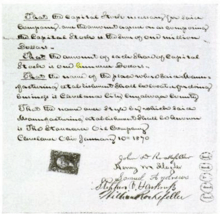Samuel Andrews (chemist)
Samuel Andrews (1836–1904) was a chemist and inventor. Born in England, he immigrated to the United States before the American Civil War, and settled in Cleveland, Ohio. He is best known as a partner in the oil refining firm of Rockefeller, Andrews & Flagler, the major predecessor company of the Standard Oil corporate empire. When the first unit was formed in 1870, Andrews owned 16.67% of Standard Oil stock. He sold his stock early on in 1874 and while he was wealthy, he did not participate in the level of wealth generation the other founders did.
He had already had some experience in shale oil production in the newly discovered oilfields of western Pennsylvania when in 1862 he approached two Cleveland produce merchants to become stockholders in a new enterprise. One was John D. Rockefeller, who saw the potential in Andrews' plan and invested in the venture. With this capital, Andrews designed and began a small refinery in Cleveland.

Ida M. Tarbell, an early investigative journalist and the author of The History of Standard Oil, described Andrews as "a mechanical genius" who "devised new processes" to create a better product. He is credited with inventing the chemical process called fractional distillation, which is the separation of crude oil into its components.
While he left Standard Oil early, he did try to display his wealth by building a mansion on Cleveland's Euclid Avenue, also known as Millionaires Row. Andrews dreamed of entertaining Queen Victoria at the home but that dream never came to fruition. The home was so large that the servants could not function and it was soon closed and remained vacant for 25 years until it was eventually bulldozed in 1923.

His better-known partners, Rockefeller and Henry Morrison Flagler, are credited with the marketing strategies and schemes that capitalized on Andrews' technical expertise. Andrews often disagreed with Rockefeller's aggressive growth and soon Rockefeller offered to buy Andrews out. Andrews took the offer and sold out all his stock in 1874. Flagler's wife's ill-health later turned his attention to Florida, where he founded the Florida East Coast Railway and helped develop many resort communities, most notably the cities of Palm Beach and Miami. While Flagler began a new career in Florida, Andrews remained in Ohio and New Jersey. He died at a hotel in Atlantic City in 1904 and his will was executed in Lakewood, dissolving his still sizeable estate.
References
- Tarbell, Ida M. The History of the Standard Oil Company. New York: McClure, Phillips & Co., 1904.